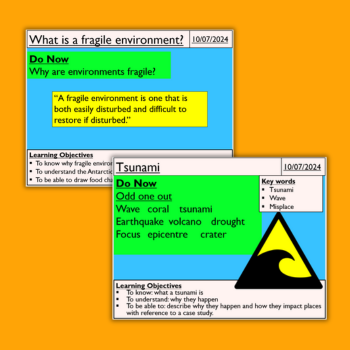This sample resource pack from This is Geography includes two lessons on physical geography.
- Tsunami
- What is a fragile environment
Each comes as a PowerPoint presentation and with accompanying Word docs. There are also separate resources for DIRT (Directed Improvement and Reflection Time), self assessment and peer assessment.
What is a fragile environment?
Learning objectives for this lesson include:
- to know: why fragile environments are changing
- to understand: the Antarctica
- to be able to: draw food chains.
Tsunami
Learning objectives for this lesson include:
- to know: what a tsunami is
- to understand: why they happen
- to be able to: describe why they happen and how they impact places with reference to a case study.
Physical geography in the KS3 curriculum
The national curriculum for geography aims to ensure that all pupils:
- develop contextual knowledge of the location of globally significant places – both terrestrial and marine – including their defining physical and human characteristics and how these provide a geographical context for understanding the actions of processes
- understand the processes that give rise to key physical and human geographical features of the world, how these are interdependent and how they bring about spatial variation and change over time.
The curriculum also requires that learners are competent in the geographical skills needed to:
- collect, analyse and communicate with a range of data gathered through experiences of fieldwork that deepen their understanding of geographical processes
- interpret a range of sources of geographical information, including maps, diagrams, globes, aerial photographs and Geographical Information Systems (GIS)
- communicate geographical information in a variety of ways, including through maps, numerical and quantitative skills and writing at length.
This is Geography is a geography author with over 700 lessons for KS2-5. Download free sample lessons here or find the whole selection at thisisgeography.co.uk. You can also follow on Twitter at @thisisgeography.











